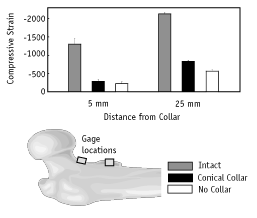1996 Project Reports | Home |
Contents | Previous |
Next |
Femoral Collar Effect on bone strains after cemented hip replacement
William A. Allen, BS Gary S. Beaupré; PhD Dennis R. Carter, PhD;
Virginia Giddings, MS; Stuart B. Goodman, MD, Ph.D; David J. Schurman, MD;
Marjolein C. H. van der Meulen, PhD
The effect of a collar in cemented hip replacement has been long debated and
remains a controversial issue. Proponents of collars believe that the collar
will transfer hip loads directly to the bone at the medial calcar, thereby
reducing proximal stress shielding and bone resorption. Critics argue that the
beneficial effects of the collar are never realized in practice since the
ability of a collar to transfer load relies on intimate contact between the
underside of the collar and the resected bone surface. Additionally, critics
contend that a collar will neither increase the proximal loading to the degree
necessary to maintain bone nor load the bone in a truly physiological manner.
In this study we evaluated the effect of a femoral collar using two implant
designs; one having a conical shaped collar and the other having no collar. By
recording the surface strains in femora before and after hip replacement we
were able to assess the performance of the two implant designs and compare the
results to the natural femur. The strain value recorded for each implant was
significantly lower than the strain value recorded for the natural femur (Fig.
1). At a location 5 mm below the collar, the strains were not different between
the two implant designs. At a location 25 mm below the collar the strain for
the conical collar implant was closer to normal, but still significantly less
than normal.
 Figure
1. Surface strains in the proximal femur before and after hip replacement.
While we did find a difference in the strain levels with and without a
collar, the biological significance of this strain difference in terms of
adverse bone remodeling is unknown. The levels of bone strain that are
necessary for bone maintenance is an important question and the focus of much
research. Based upon the present study, we believe that the conical collared
implant will perform better in terms of minimizing adverse bone remodeling
after total hip replacement.
|
Republished from the 1996 Rehabilitation R&D Center Progress Report. For
current information about this project, contact:
William A. Allen.

